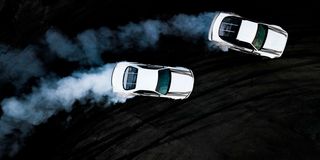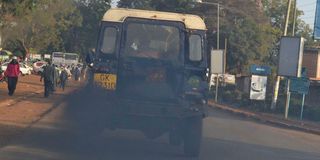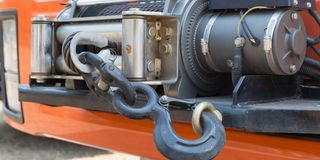Premium
How to make sense of your diesel engine black smoke signals

A bus emitting black smoke from its exhaust in Abidjan on September 15, 2016.
Thirsty engines and black smoke

Stopping the black smoke from diesel engines will reduce your fuel consumption.
Why does a Nissan YD25 diesel consume a lot of fuel and produce black exhaust smoke?
Waithaka D
All diesel engines produce black smoke if they don’t properly and fully burn the fuel they are being fed. That happens when either they are supplied with too much fuel (a problem with the injectors) or too little air (a clogged air filter or faulty mass airflow sensor, aka EGR) or the compression in the combustion chamber is too low to complete combustion (the piston rings are worn or the valves are faulty), or the combustion timing system is out of kilter (the timing chain has stretched or sprockets are worn or damaged). These general principles apply to all diesel engines. Hearsay is not kind about YD25 timing chains.

All diesel engines produce black smoke if they don’t properly and fully burn the fuel they are being fed.
The remedies are self-evident but the costs are uncertain. If the injectors are simply fouled with dirt and maladjusted, a good clean and resetting on a test bench could be the cure.
At the other extreme the defects in the injector might be beyond repair and more expensive new parts will be needed. So, too, with the engine wear or sticky valves. New rings and a decoke are the likely minimums. A major engine overhaul is at the other end of the scale.
Don’t delay having the fault found and fixed.
It will ultimately save you money because stopping the black smoke will also reduce your fuel consumption.
Are winches safe to use in any vehicle?

Winches vary in size and pulling power from about 1,000 kilos to more than ten times that.
I have just bought a used 4WD which has a large winch on its front bumper. I have never used one and have no idea how to do so properly and safely. How can I find out? Can I just have it removed and sold or should I leave it in place?
Kyalo.
Unless you do a lot of extreme expeditions or wilderness work, you hardly ever will use it. But at crucial moments it could transform your ability to get yourself (or others) out of trouble.
By your choice of vehicle, I suspect you are not unfamiliar with safaris, but I strongly advise you to talk to someone with winch experience before making your debut with a winch. These are very powerful bits of kit that can cause considerable damage or serious injury if not used properly. You will also find some useful (though rather idealised) video tutorials on the internet.
To those, you need to add serious common sense to deal with real-life situations.
Winches vary in size and pulling power from about 1,000 kilos to more than ten times that. Most fitted to serious 4WDs are rated around 4,000 kilos and have cables about 50 metres long. Early vehicle winches were mostly powered by the vehicle’s engine, through a power-take-off shaft (PTO). Nowadays, they are mostly powered by electric motors, big enough to very rapidly drain your battery unless you keep the engine running (so the alternator takes the discharge load) while using them.
Traditionally, their cables were all multi-stranded steel wire; more recently, high-tech synthetic fabrics are increasingly used, because they are lighter, more flexible, easier to handle, and less prone to fraying into sharp spikes. With either type, very thick gloves are an essential safety kit. Either type can be extremely effective, and with doubler pulleys, they can pull twice their rated strength (and at half-speed).
Technically you can fit two or more doublers at either end, so there are three or four runs of cable between the puller and pulled. The distance of pull and winding speed is divided by the number of lengths; the pulling power is multiplied by the same number! But they do need an “anchor” – whether the winch is on the stuck vehicle or a rescuer. The potential is limited by the sturdiness of the anchor to keep one end of the cable stationary while all that muscle is applied.
If a stuck or stricken vehicle is winching itself, there needs to be a tree or stout bush or other immoveable object (huge boulder) within reach. The winch hook should not be wrapped around the anchor (eg a tree trunk) and hooked back on its own cable (that could seriously damage the cable…and the tree). There needs to be a “”collar of rope, belt or chain around the anchor, and the winch hook should be tied top that with D clamps. In the absence of a handy tree, there are specialised “anchors” ranging from augers to steel spikes with baseplates; in extremis a spare wheel can be buried upright and side-on in the ground to anchor the cable hook.
Every aspect of winching needs to be done properly and carefully. If the cable or the anchor points fail under full load, the hook and/or cable can recoil in unpredictable directions at very high (and potentially lethal) speeds. No one should stand near the cable when it is under load. The remote should have a long extension lead so the operator can stand well away or even get inside the vehicle.
After use, it is essential to rewind the cable tightly and neatly (ie under sufficient load and in regular layers). When the winch is next used and part of the cable is put under a very heavy load, it could cut through layers of loose winding and jam the spool. When winching your own or another vehicle up a steep bank, rocks or other wheel chocks should be constantly moved close to the lower wheels in case of cable failure.
If the winch is on a rescue vehicle, that vehicle might also need to be anchored so it doesn’t just pull itself towards the vehicle it is trying to rescue. A big winch can readily pull the vehicle it is fitted to, even with its bakes full on. Its tail might need to be tied to a tree or large rocks might need to be placed in front of its wheels. Imagination and common sense are the necessary ingredients.
Winches can be removed, and you certainly have the option to sell yours separately. The front of your car might breathe a sigh of relief – older winch designs with tall gears and steel cables weigh about 70 kilos! If it is a quality brand and in good working order it has considerable value…in cash or usage.
Car safety cannot be added on. It must be built-in…to everything!

Why has Kenya failed so emphatically and for so long to achieve higher standards of road safety?
Elijah
Road safety is important. Very important. But it is not the only nor the most essential issue in road transport. The fundamental purpose and priority is a system that will deliver people and goods from one place to another. That is what a road transport system does; that, before and above anything else, is why it exists in the first place. Administrators sometimes seem to forget that.
The first question, then, is whether the whole system does its main job perfectly, quite well, moderately, poorly or appallingly badly.
The second question is what do you measure when making that assessment?
Again, safety will be a criterion, but not necessarily the first nor most important. Arguably, the axiomatic priority is “availability”: enough roads and vehicles. Enough to adequately mobilise the national population and every element of the economy – as efficiently as possible.
So next comes the quality and condition of those roads and vehicles, because they are inherent determinants of the performance, reliability, economy (and safety!) of the system.
The ability of roads and vehicles to deliver those secondary values will depend on the competence and conduct of planners, contractors, inspectors and mechanics as well as road users, and the skills and diligence of administration (things like traffic management, law-making and enforcement).
Those elements and road user standards will depend —onwards and outwards and forwards and backwards — on the general quality and levels of basic education, skilled driving tuition, strict testing, specialist training of all players, public education on all these issues, and social integrity values. And, governing and directing effort in all those respects, for better or worse, is policy.
The key point that emerges here is that safety cannot be added on to a road transport system. It must be built into it. All of it.
It is essential for both the public and policy (and the police) to always bear in mind the competence and attitude of drivers.
Whether the infrastructural conditions are good or bad, driving standards play a crucial role in making the best or worst of what they are.
So in parallel with all the other ingredients of a road transport system, it is fundamentally important to include the standards of driving tuition and to test learners thoroughly and strictly before issuing a Certificate of Competence.
Because the majority of licenced drivers have neither of these advantages, serious resources should be devoted to practical, positive, helpful (not legally pedantic) public education. More on that some other time.
Bottom line, safety standards will not improve while policy, administration, infrastructure and enforcement focus mainly on the “outcomes” and not much on the “root causes” of danger; blaming road users but never themselves for the faults and consequences, with almost every remedial measure focused on punishing the road-using public (often unreasonably or unfairly and even illegally) while self-granting immunity for their own shortcomings.
If policy focuses on punishing drivers instead of supporting, educating and assisting them, and meanwhile allows corruption to undermine the legitimate processes that are in place, over decades this will not lead to improvement; it will foster a social attitude of “us and them”, in which one side wants freedom and efficiency, and the other wants revenue.
The current message is not the rule of law. It is that lawlessness rules…on both sides of the driver’s window.





